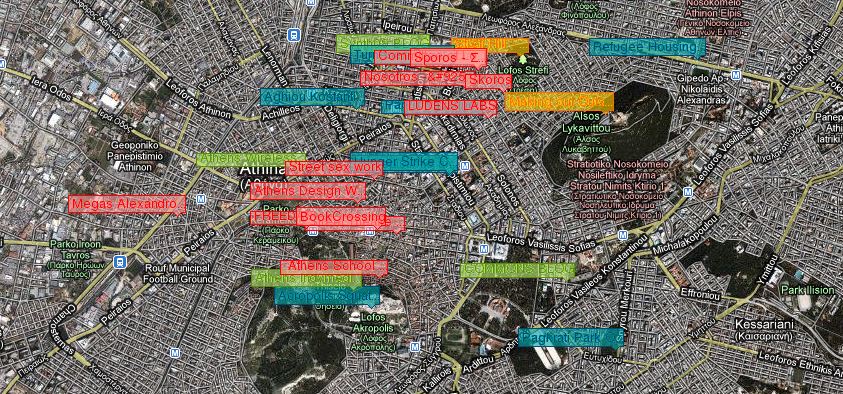Mapping the commons of Athens
Mapping the Commons of Athens took place at the end of 2010, at the year when Greece started losing its financial independence. Six months after the first memorandum with IMF and the implementation of the first austerity measures, the Greek capital was called upon to play a new role. Athens was invited to become the “beta” city of crisis, to constitute the experimental ground for the emerging transitional economic period and to confront first in Europe the impasse of late capitalism. The metropolis looked vulnerable but also restless, and its territory was the one where older and newer forms of resistance and counter-practices were about to be formed but also challenged.
Inspired by the thought of Hardt and Negri, the workshop ‘Mapping the Commons, Athens’ aimed to study and empower these emerging forms of resistance, by focusing on the city’s most significant wealth, its commons.[2] If “the city is the source of the common and the receptable into which it flows” as the philosophers argue, then a cartography of the commons for the city of Athens, a city in times of crisis, would be able to highlight the city’s living dynamic and its possibility for change. With this goal in mind, the team was faced with an interesting but difficult challenge; to emphasize the wealth of the metropolis by turning to the affects, languages, social relationships, knowledge and interests of its multitude; to build a cartography based on commons that to a great extent were immaterial and abundant, fluid and unstable and to therefore try to respond to certain difficult questions: How can the new artificial commons be mapped? Do they emerge in times of crisis? Do they constitute a form of resistance and which are the new dangers of enclosure that need to be faced?
After discussions and meetings with people from different areas working on the commons, the participants of the workshop in collaboration with the team of Hackitectura proceeded first to the documentation of the urban commons as part of a research online map and then to the making of short video case studies, as part of an interactive video cartography presenting representative commons found in the city . Seeing beyond the “public” and the “private”, this collective effort aimed to offer to the inhabitants of Athens a new useful tool and a different reading for their city. The types of commons that were mapped are based on collectivity, sociability and sharing; they are encouraging open and free access and peer to peer practices. The database is rich and wide varying from squatted and self-managed parks in the heart of the city to digital platforms for the sharing and upcycling of objects; from anger and its expression on the streets[3] to the thousand wireless network nodes open in the city, from the critical mass of cyclists demanding roads for people not cars to the language as main common, from the free software and P2P[4] to the parties demanding the ludic use of the streets, from the animals as fellow humans[5] to graffiti as common artistic expression on the city walls . The workshop also produced a blog documenting the progress of work and an installation hosted at the National Museum of Contemporary Art after the completion of the work.
Six years later, the maps produced are still on view online and remain open to further contributions by anyone interested. Seen by their creators as databases of exchange, the hope was and still is to inform the inhabitants about spaces where communities of commoners are formed and to empower the city’s ground for social encounters and experiences. Built as a result of a truly “common” effort, they were based on the belief that the exit from impasse of the crisis can possibly be found through creativity that embraces the ideas of sharing and co-producing.
This activity is supported with: